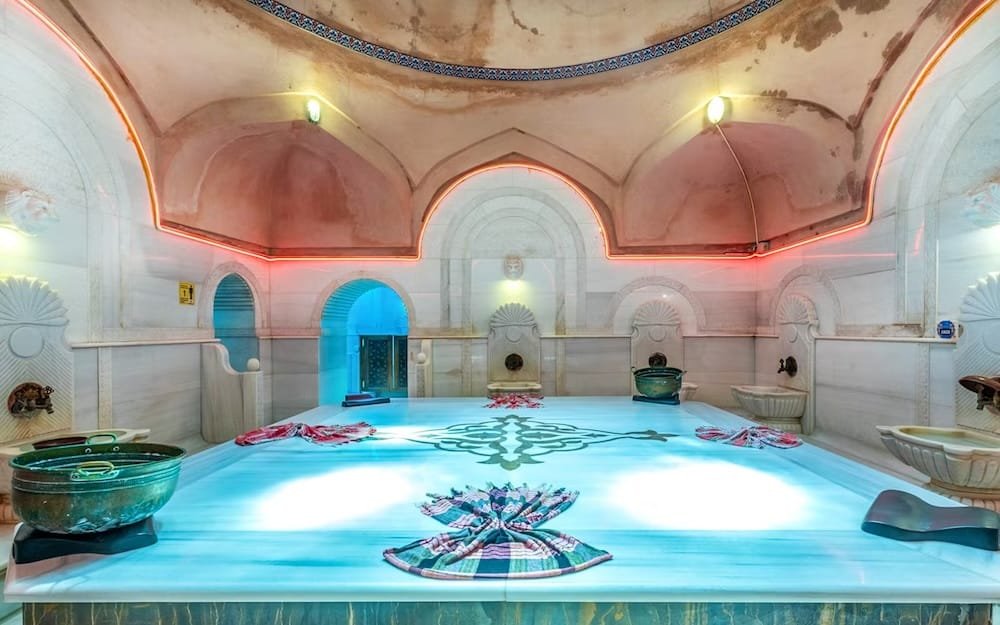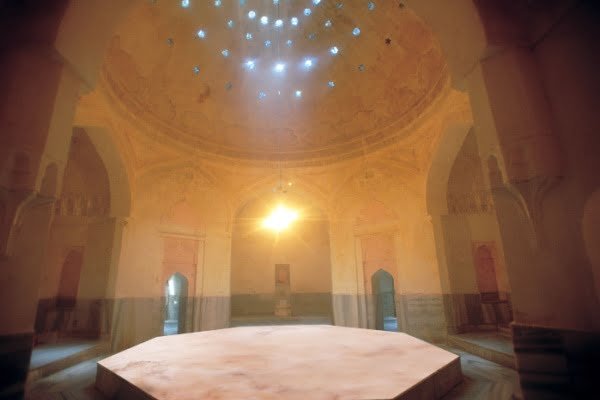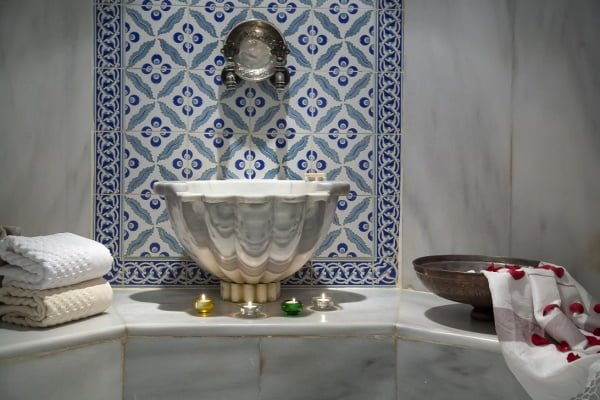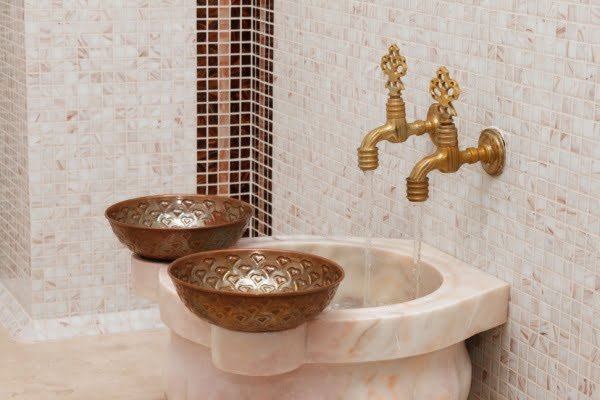Best Hamam in Istanbul
Best Hamam in Istanbul
Istanbul, the historic capital of Turkey, is famous for its traditional Turkish baths. With a history spanning thousands of years, Turkish baths have been serving as a perfect place for cleanliness, relaxation, and spiritual rejuvenation.
In this guide, get ready to explore the two best hamams in Istanbul. With their unique architecture, relaxing atmosphere, and traditional bath rituals, these baths offer an unforgettable experience. These establishments, which present the finest examples of bath culture to visitors to Istanbul, aim to provide travelers in the city with a unique Turkish bath experience.
If you’re ready, let’s start exploring the best hamams in Istanbul, then we continue with the fascinating facts and the architecture of turkish baths!
Which are the Two Best Hamams in Istanbul?

Historical Cemberlitas Hamam in Sultanahmet
The Çemberlitaş Hamamı is a historical Turkish bath located in the Sultanahmet district of Istanbul. It was constructed by the famous Ottoman architect Mimar Sinan during the reign of Sultan Süleyman the Magnificent in the 16th century. The hamam features an impressive octagonal dome and traditional Ottoman architecture. It has separate sections for men and women and offers a variety of bathing services, including steam rooms, hot and cold baths, and massage treatments.
Çemberlitaş Hamamı is not only a place for cleansing and relaxation but also a significant cultural landmark that reflects the rich heritage of Turkish bath culture.
Location: Cemberlitas Hamam Mollafenari, Vezirhan Cd. No: 8, 34440 Fatih, Istanbul
Find on Google Maps: Tickets to Historical Cemberlitas Hamam in Sultanahmet

Authentic Cagaloglu Hamam
The Çağaloğlu Hamamı is an authentic Turkish bath located in the historic Sultanahmet district of Istanbul. Dating back to the 18th century, it is one of the oldest and most renowned hamams in the city. Designed by the famous Ottoman architect Süleyman Ağa, the hamam features stunning Ottoman architecture with domed ceilings, marble interiors, and intricate tilework. It offers separate bathing sections for men and women, each with its own steam room, hot and cold baths, and massage area. Visitors to Çağaloğlu Hamamı can experience the traditional ritual of Turkish bathing in a historic and atmospheric setting, immersing themselves in centuries-old traditions of cleansing, relaxation, and rejuvenation.
Location: Alemdar, Prof. Kazım İsmail Gürkan Cd. 11-13, 34110 Fatih/İstanbul, Türkiye
Find on Google Maps: Istanbul: Cagaloglu Hamam Experience
Quick Facts About Hamams (Turkish Baths)
- Official Name: Turkish Baths
- Founded: 15th century
- Location: Turkey, North Africa, the Middle East, and South Eastern Europe
- Architectural Style: Ottoman and Islamic architectural styles
- Origins: Turkish baths, also known as hammams, have their origins in ancient Roman bathing traditions but evolved into distinct cultural institutions under the influence of the Ottoman Empire.
- Purpose: Turkish baths served as communal spaces for cleansing, relaxation, and socializing. They were an integral part of daily life and played important roles in hygiene, health, and social customs.
- Interior Area Design: Typically, a hammam consists of a large sıcaklık (heated room) with a göbek taşı (raised marble platform) in the center, a şadırvan (shallow pool), along with smaller soğukluk (cooler changing rooms).
- Main Architects: Mimar Sinan (1490-1588), Mimar Koca Sinan (1539-1617), Mimar Hayruddin (1520-1588)
- Cultural Importance: Turkish baths hold significant cultural and historical importance in Turkish society. They have been depicted in art, literature, and folklore for centuries and remain cherished symbols of Turkish identity and heritage.
- Modern-Day Hammams: While traditional hammams continue to exist, many have been adapted to modern lifestyles and offer spa-like amenities and services. Visitors can still experience the time-honored rituals of Turkish baths while enjoying contemporary comforts.
- Tourism: Turkish baths are popular tourist attractions in Turkey, particularly in cities like Istanbul, where historic bath houses draw visitors from around the world seeking an authentic hammam experience.
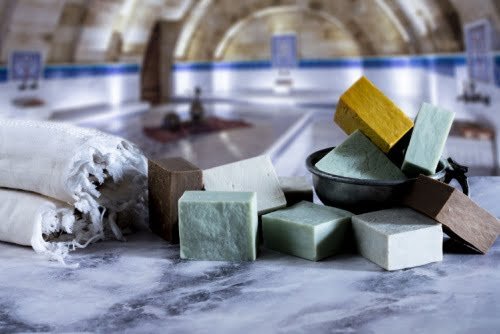
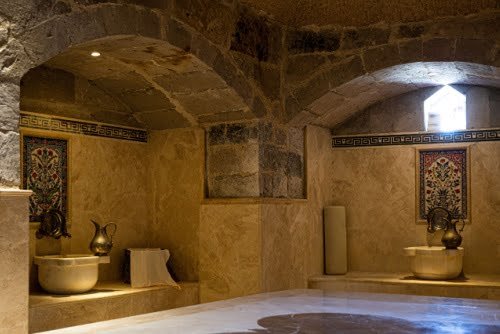
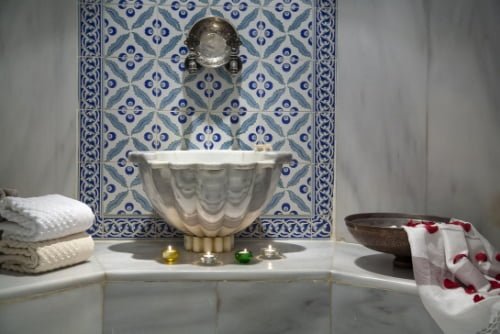
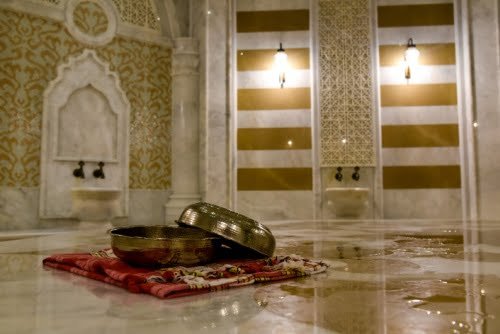
Architecture of Turkish Baths
- Marble Surfaces: Turkish baths are renowned for their use of marble, both for its aesthetic appeal and its practical benefits. Marble surfaces line the floors, walls, and benches of the bathing chambers, providing a smooth and hygienic environment for bathers.
- Dome: One of the most prominent features of a Turkish bath is its central dome, which often serves as the focal point of the building. The dome is usually adorned with intricate geometric patterns, star-shaped skylights, and colorful stained glass windows, allowing natural light to filter into the interior space.
- Pillars and Arches: Supporting the domed roof are sturdy pillars and arches, which add structural stability to the building while also contributing to its architectural grandeur. These architectural elements are often embellished with decorative motifs and intricate carvings.
- Decorative Tilework: Turkish baths are adorned with elaborate tilework known as “çini” or “çiniler,” featuring intricate patterns, floral motifs, and geometric designs. These tiles are often handcrafted and hand-painted, adding to the beauty and elegance of the bathhouse.

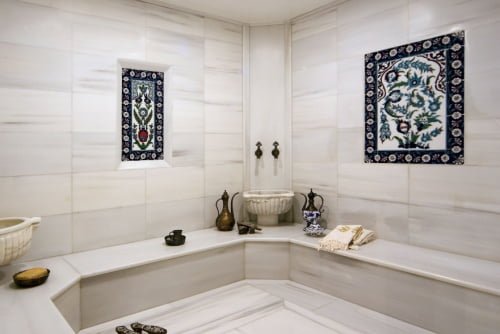


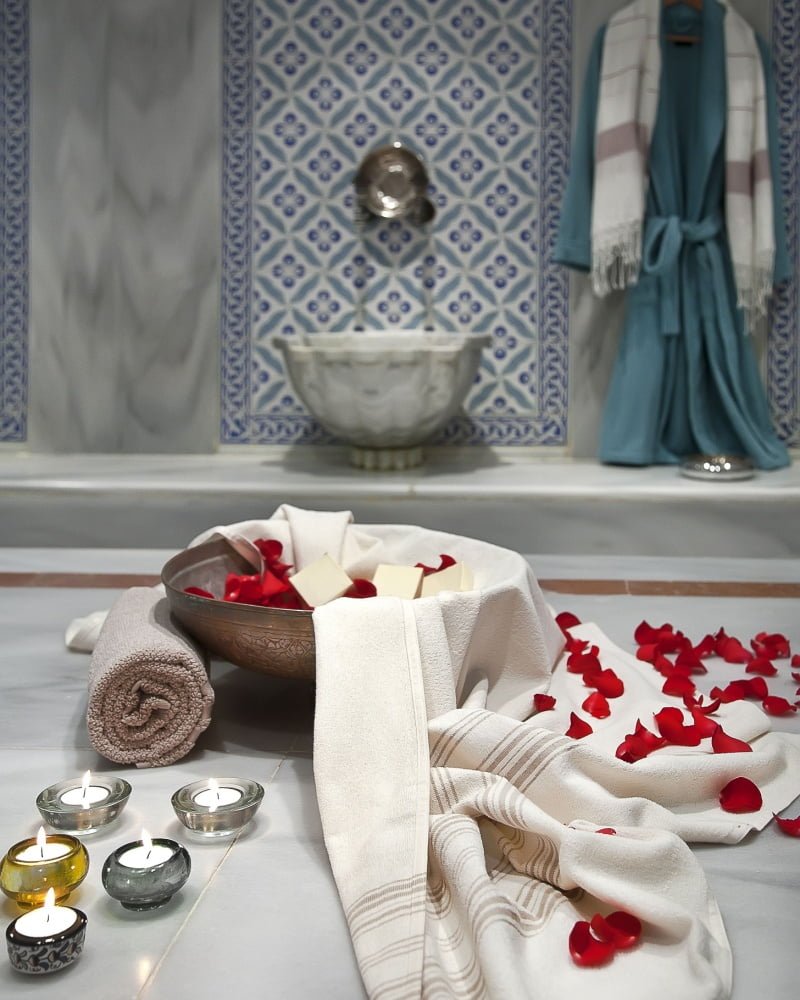
Structure of Turkish Baths
A Turkish Bath’s architecture is characterized primarily by specific materials and structures. The materials used in the construction of these baths include stone, brick, marble, wood, and tile. These materials are known for their strength, durability, and ability to retain heat. Turkish baths are typically built with domes that help maintain both temperature and humidity. The walls are often covered with marble and ceramic tiles for decoration, and the floors are covered with marble and stone for durability. The domed ceiling is usually made of wood, plaster, and tile and is designed to absorb steam and condensation and provide insulation for the steam room. The cold plunge pool is made of marble, stone, and ceramic tiles and is built to deliver a refreshing escape from the intense heat of the steam room. The baths also feature an assortment of amenities, such as massage tables, fountains, and seating areas.
FAQ – Best Hamam in Istanbul
Best Hamam in Istanbul: Tickets
Explore below our curated selection of Hamam Istanbul (Turkish Baths) tickets and guided tours:
Best Turkish Bath in Istanbul for Couples
Acemoglu Hammam: Turkish Bath, Spa & Massage in Eminönü
Experience relaxation at the 18th-century Acemoğlu Hammam, a mixed-gender local favorite tucked away in Eminönü. With original Ottoman architecture, intimate lighting, and warm marble interiors, it’s ideal for couples looking for a genuine, shared hammam experience. Choose from public, semi-private, or fully private packages including scrubbing, foam massages, and optional spa add-ons.
Camille, March 2025: “I had the Turkish bath + 30 min massage experience with my two friends and I recommend it 100%. We had an incredible time”
Bestselling Turkish Bath Experience in Istanbul
Cemberlitas Hammam: Turkish Bath & Spa in Sultanahmet
Step into history at the 500-year-old Çemberlitaş Hamam, designed by the legendary architect Mimar Sinan. Located just steps from the Grand Bazaar, this classic Ottoman bathhouse features a dramatic domed hall, heated marble platforms, and a steam-filled ambiance that evokes centuries of tradition. Enjoy a traditional scrubbing and foaming ritual, followed by Turkish tea in a quiet corner of this historic gem.
Marija, July 2023: “Clean and pampering. Massages are great too. Center of town.”
Celebrity-Favorite Hamam in Istanbul
Istanbul: Cagaloglu Hamam Experience
Experience timeless luxury at the 18th-century Cagaloglu Hammam, one of Istanbul’s most renowned historical bathhouses, visited by figures like Florence Nightingale and Kaiser Wilhelm. Known for its elegant blend of Ottoman and Baroque architecture, this hamam offers top-tier service, marble interiors, and a peaceful escape in the heart of the Old City. A perfect mix of heritage and pampering.
Ana Luisa, March 2024: “Highly recommended, there are other cheaper places but this one is worth it, the service is great.”
Bestseller – Private Luxury Option
Istanbul: Private Turkish Bath, Sauna, and Massage
Indulge in a fully private Turkish bath experience, designed for complete relaxation and discretion. Step into a serene space with a private sauna, warm marble platforms, and the soothing scent of essential oils. Choose from customizable treatments including scrubs, foam massages, facials, and more—perfect for solo travelers, couples, or those seeking a luxury wellness escape in Istanbul.
Severin, April 2024: “The entire package was just great. From the reception to the massage to the hammam, we felt completely at home.(..) The price/performance ratio is absolutely perfect.”
>> Evaluate all available choices using our comparison table and select the optimal ticket.

